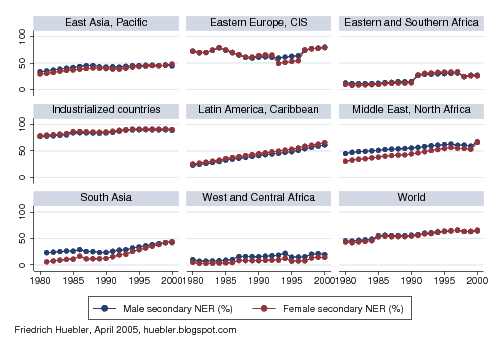An analysis of regional trends in secondary education is less reliable than a similar analysis at the primary level because of a lack of data. A previous post on secondary school enrollment made clear that for many countries in Africa and South Asia the secondary school NER is unknown. In East Asia, there is no data for China and in Eastern Europe, there is no data for Russia. For these regions, the trends presented below should therefore be interpreted with caution.
Secondary school net enrollment ratio, 1980-2000

Data sources: UNESCO Institute for Statistics (UIS). 2004. Global Education Digest 2004. Montreal: UIS. - World Education Indicators, UNESCO Institute for Statistics, March 2005.
The regional groupings in the graph were adopted from UNICEF (see the map in a post on regional trends in primary school enrollment). Of all regions, Latin America and the Caribbean witnessed the strongest increase in secondary school enrollment; in 1980, the secondary school NER was 27% and in 2000 it was 63%. In the Middle East and North Africa and in South Asia, the countries for which UNESCO provides data managed not only to increase enrollment overall, they also reached gender parity in secondary education. As in primary education, Sub-Saharan Africa continues to lag behind the other regions.
Friedrich Huebler, 20 April 2005, Creative Commons License
No comments:
Post a Comment